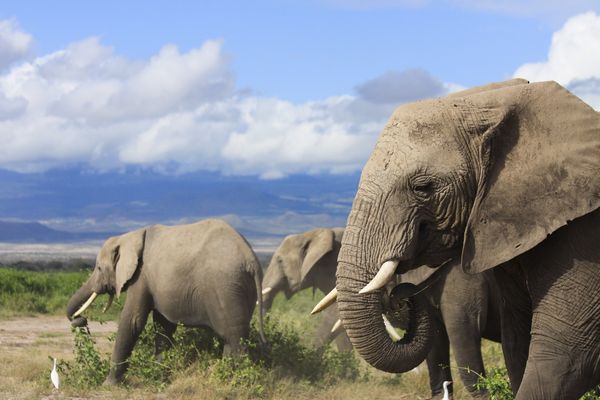Orphan Elephants Lack Social Knowledge Key for Survival
An elephant family moves through Kenya's Amboseli National Park.
Highly intelligent and social animals, African elephants depend on their sophisticated communication skills for survival in the wild. A recent study investigated the effects of culling and relocation on elephant decision-making and cognition decades later.
Behavioral ecologists from the University of Sussex in England led an international team to study two different elephant populations: one relatively undisturbed group living in Amboseli National Park in Kenya and another translocated population in Pilanesberg Park in South Africa. The Pilanesberg elephants were moved there as calves following managed culling of adults and older juveniles in Kruger National Park in the 1980s and 1990s.
Survivors from the translocated elephant group showed signs of negative long-term psychological impact that affected their decision-making process, paralleling post-traumatic stress disorder (PTSD) in humans, according to the study, which was published in Frontiers in Zoology on October 23, 2013.
Complex Society
Elephants develop complex social relationships over long life spans. Long-term learning and knowledge transfer in the Pilanesberg population was deeply affected by the culling, the study found.
"Human-generated social disruption has profound effects on important decision-making abilities in wild African elephants that are likely to impact key aspects of their social behavior," said Graeme Shannon, a University of Sussex psychologist who, along with colleague Karen McComb, led the study.
Call of the Wild
Through a series of acoustic playback experiments, the scientists found that human activities, including culling and relocation, have a profound impact on the communication skills, social understanding, and overall cognition of wild African elephants.
While other studies have looked at physiological and behavioral impacts on elephants from extreme human disturbance, such as poaching, this study was the first to assess their fundamental communication skills and cognitive abilities in the wild, Shannon said.
The researchers conducted two elephant call experiments. The first presented elephants with different calls—familiar and unfamiliar—to directly compare their social knowledge. The second experiment simulated calls from elephants of different sizes and ages in correlation with hierarchal dominance. They wanted to see how elephants responded to and understood different levels of social threat through their behaviors, specifically how they used listening skills, investigative smelling, and defensive group formation.
When an elephant family is threatened, they will often bunch together as a group, creating a defensive formation where calves move toward older individuals in the center, the most protected area.
The ability to "distinguish friend from foe," McComb said, "enables defensive responses to be focused on genuinely threatening situations." The calls "provided a way of getting at cognitive abilities that are usually inaccessible in wild elephant populations."
Social Experiment
During the playback experiments they tested how elephants reacted to non-threatening social calls, including those from familiar and young individuals, and more threatening calls, such as those from unfamiliar and older individuals.
They found Amboseli elephants made better decisions in recognizing threatening calls, reacting with stronger listening, sniffing, and bunching behavior, showing that they focused their attention on the most socially dominant individuals, a critical defensive measure.
The Pilanesberg elephants were not able to discriminate in this way—the elephants did not change their response based on the social familiarity or dominance of the caller.
Effects of Culling
Effects of culling and subsequent translocation are twofold. Initial trauma is followed by a subsequent lack of leadership and group role models. The orphaned elephants from Kruger did not have older role models to learn from in Pilanesberg.
"They had experienced terrible trauma," said biologist and conservationist Joyce Poole, another author of the study and a National Geographic explorer. "These calves watched as their mothers and other family members were killed and butchered. Because the people in charge of culls didn't understand the long-term implications, didn't understand they were dealing with intelligent, highly social animals, they, for convenience, tied the calves to their dead mothers while the butchering took place," Poole said.
"The elephants who had grown up without the benefit of role models respond very differently to threats than do families with an older, experienced matriarch," Poole said.
In highly cognitive and social species, like elephants and primates, social trauma early in life can have major effects on development, the researchers reported, such as persistent fear, hyper-aggression, and infant abandonment.
"Such disruption appears capable of driving aberrant behaviors in social animals that are akin to the post-traumatic stress disorder experienced by humans following extremely traumatic events," the study noted.
Mental and Physical Effects
Without the ability to learn from older leaders, such as the matriarch and other group elders, young elephants suffer a profound loss of social knowledge, affecting their ability to make informed decisions, a deficit that impacts their overall social behavior.
"Rather than focusing energy on genuine threats," said McComb, "their behavior will be randomly disrupted—this could impact on feeding and ultimately reproductive success."
Ongoing Threats
War, poaching, human disturbance to the landscape, translocation, and capture remain issues facing elephant populations.
"Poaching presents the greatest threat to elephants today as a result of increasing demand for ivory," Shannon said.
"Poaching is severely damaging the fabric of elephant societies, killing, wounding, and causing long-term trauma to individuals," Poole said. "The social consequences of this escalating persecution can be seen across Africa, and will have repercussions in the years to come."
Social Societies for the Future
Conservationists hope to apply the lessons learned toward future conservation efforts for other long-lived, large-brained social animals, including whales, dolphins, and primates.
Learning and communication is critical for the health and survival of these social societies. Pressure on natural resources and human encroachment is increasing.
"How a matriarch responds to threats can mean the difference between life and death for her family," Poole said. "If you were an elephant, would you lead your family to charge a gang of humans with AK-47s? Or would you run as fast as you can into the forest?"
National Geographic Society funded this study in part.
Christy Ullrich Barcus
National Geographic
Published October 31, 2013












